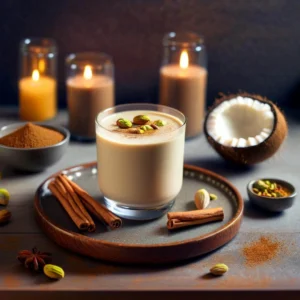Sahlab: More Than Just a Drink
Sahlab Recipe is more than just a traditional drink; it’s a comforting, fragrant experience that has transcended time and geography to become a beloved beverage in many parts of the Middle East, Mediterranean, and beyond. With its creamy, smooth texture and delicate flavors, sahlab brings warmth to the soul and a sense of nostalgia to those who have grown up sipping it during the cold months. Traditionally associated with winter, this drink provides relief from the chill with its soothing consistency and comforting ingredients. Beyond its physical warmth, sahlab also offers a cultural connection, drawing on centuries of history, tradition, and artistry in its preparation and consumption.
The Orchid-Based Origins of Sahlab
At its core, sahlab originates from the ground tuber of the orchid plant, Orchis species, native to the Middle East and parts of the Mediterranean. The starch derived from the tuber gives sahlab its characteristic creamy texture, setting it apart from other hot beverages like hot chocolate or coffee. The name “sahlab” comes from the Arabic word for orchid, highlighting its natural origins and the distinctive properties of the plant. Traditionally, people used sahlab powder to prepare the drink, but it also enriches various culinary applications, such as Turkish cuisine, where it thickens creamy puddings and savory sauces.
A Royal and Cultural Tradition
Sahlab has deep roots in the cultural traditions of the Middle East, where people have enjoyed it for centuries. In the past, it was considered a luxury item, often prepared as a special treat for royalty or the elite. Combining sahlab powder with milk, sugar, and fragrant spices like cinnamon and nutmeg creates a rich, indulgent drink, cherished for its soothing qualities and believed to have healing benefits. Many believed sahlab helped with digestive issues, provided warmth during cold months, and even boosted energy levels. It became particularly popular in colder climates, where the rich, caloric beverage helped people stay warm and nourished throughout long winter months.
The Global Spread of Sahlab Recipe
Over time, sahlab’s popularity expanded beyond its original Middle Eastern roots to other regions. Today, people in Turkey, Lebanon, Egypt, Syria, and Iran consider it a winter favorite, commonly served at cafés, family gatherings, and festive occasions. In Turkey, street vendors frequently sell sahlab, integrating it into the bustling social culture. Across different countries, regional variations have introduced unique twists to the traditional recipe, ensuring its enduring appeal.
The Unique Texture and Flavors of Sahlab
The unique allure of sahlab lies in its rich, velvety texture and aromatic flavors. At its simplest, the drink involves dissolving sahlab powder in warm milk and sweetening it with sugar. What sets sahlab apart from other milk-based beverages is the careful balance of spices and flavorings that enhance its complexity. Many people add rosewater or orange blossom water, infusing the drink with floral notes that complement its creamy base. Ground cinnamon and nutmeg frequently top the drink, adding warmth and depth. Additionally, chopped pistachios, shredded coconut, or raisins may serve as garnishes to provide texture and sweetness. This combination of flavors creates a drink that feels both familiar and exotic, soothing yet exciting, and above all, deeply comforting.
Versatility and Adaptability Across Cultures
Sahlab’s charm stems from its ability to adapt to local tastes and preferences. Some prefer it as a simple, sweet beverage, while others transform it into an elaborate dessert, topped with whipped cream or drizzled with honey. This versatility has helped it endure for centuries, solidifying its place as a beloved drink across countless cultures and communities. Many families pass down the tradition of preparing and drinking sahlab, fostering togetherness and sharing a moment of warmth and indulgence.
Challenges in Producing Authentic Sahlab
In recent years, producing authentic sahlab has become increasingly difficult. Overharvesting and environmental changes have endangered the wild orchid species traditionally used to create sahlab powder. As a result, many producers have turned to alternative sources, such as cornstarch or other starches, though these substitutes lack the distinctive properties of the original ingredient. Despite this, people continue to enjoy sahlab in various forms worldwide, keeping the tradition alive.
Sahlab in Modern Cafés and Homes
Today, cafés, restaurants, and homes serve sahlab alongside other Middle Eastern and Mediterranean delicacies. It remains a staple at special occasions, including family gatherings, religious holidays, and festive celebrations, reinforcing its reputation as a symbol of warmth, hospitality, and rich cultural heritage. Whether sipped alone on a quiet evening or enjoyed with friends and family, sahlab brings people together, offering not just warmth and comfort but also a taste of history and tradition in every cup.
Recipe: How to Make Authentic Sahlab Recipe
Ingredients Table
| Ingredient | Quantity |
|---|---|
| Milk (dairy or plant-based) | 2 cups |
| Sahlab powder (or cornstarch) | 2 teaspoons |
| Sugar | 2 tablespoons (adjust to taste) |
| Rosewater or orange blossom water (optional) | 1 teaspoon |
| Ground cinnamon | For garnish |
| Chopped nuts, shredded coconut, or raisins | Optional, for topping |
Preparation Steps
- In a small bowl, mix the sahlab powder (or cornstarch) with a few tablespoons of cold milk to form a smooth slurry.
- Heat the remaining milk in a saucepan over medium heat, stirring occasionally.
- After heating the milk, add the sugar and stir until it is completely dissolved.
- Gradually add the sahlab slurry to the milk, stirring constantly to avoid lumps.
- Keep cooking, stirring constantly, until the mixture thickens to a creamy, pudding-like texture.
- Remove from heat and add rosewater or orange blossom water, if using.
- Pour the sahlab into cups, dust with ground cinnamon, and top with a garnish of nuts, shredded coconut, or raisins, according to your preference.
Nutritional Information (Per Serving) for Sahlab Recipe
| Nutrient | Amount |
| Calories | 180-200 kcal |
| Carbohydrates | 30g |
| Protein | 5g |
| Fat | 5g |
| Sugar | 18g |
Frequently Asked Questions (FAQ) About Sahlab Recipe
What is sahlab made of?
Sahlab is traditionally made from ground orchid tubers, but modern versions often use cornstarch as a substitute.
Is sahlab vegan?
Yes, if made with plant-based milk and a non-dairy sweetener, sahlab can be enjoyed as a vegan drink.
Where can I buy sahlab powder?
Authentic sahlab powder can be found in Middle Eastern grocery stores or online specialty retailers.
How does sahlab taste?
Sahlab has a creamy, thick texture with a mildly sweet and floral flavor, complemented by cinnamon and nutmeg.
Can I make sahlab without cornstarch?
Yes, arrowroot or potato starch can be used as an alternative thickener.
Conclusion
Sahlab Recipe is more than just a drink—it’s a warm embrace of tradition, history, and culture in a cup. Whether enjoyed as a simple winter beverage or a festive treat, it brings people together through its comforting flavors and rich heritage. Despite challenges in sourcing authentic ingredients, its legacy continues, ensuring that sahlab remains a cherished part of Middle Eastern and Mediterranean culinary traditions for generations to come.

Sahlab Recipe: A Traditional Middle Eastern Drink for Warmth
Equipment
- Small bowl
- Saucepan
- Whisk
- Cups
Ingredients
- 2 cups milk (dairy or plant-based)
- 2 teaspoons sahlab powder (or cornstarch)
- 2 tablespoons sugar (adjust to taste)
- 1 teaspoon rosewater or orange blossom water (optional)
- Ground cinnamon (for garnish)
- Chopped nuts, shredded coconut, or raisins (optional, for topping)
Instructions
- Preparation Steps:Mix sahlab powder with a few tablespoons of cold milk in a small bowl.Warm the rest of the milk in a saucepan over medium heat.Stir in sugar and dissolve completely.Gradually add the sahlab slurry, stirring constantly.Cook until thickened to a creamy consistency.Remove from heat and add rosewater or orange blossom water.Serve with a sprinkle of cinnamon and toppings like nuts or raisins.

